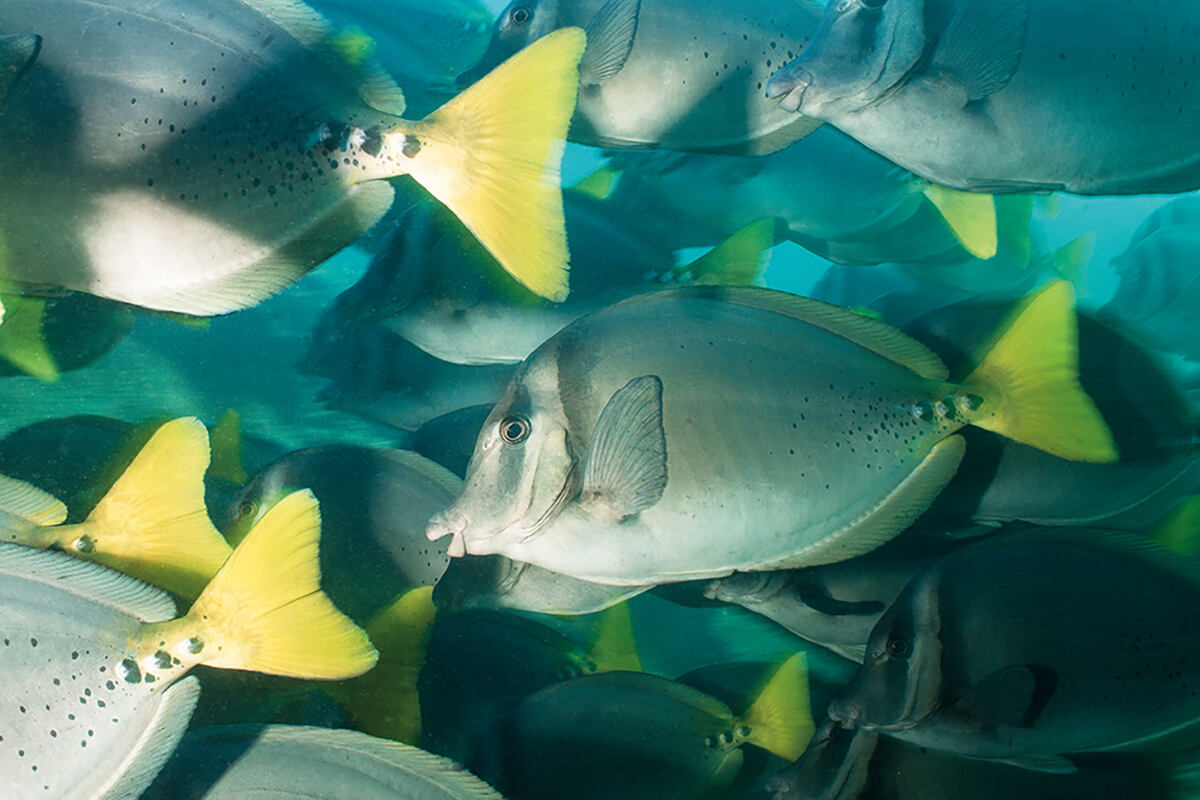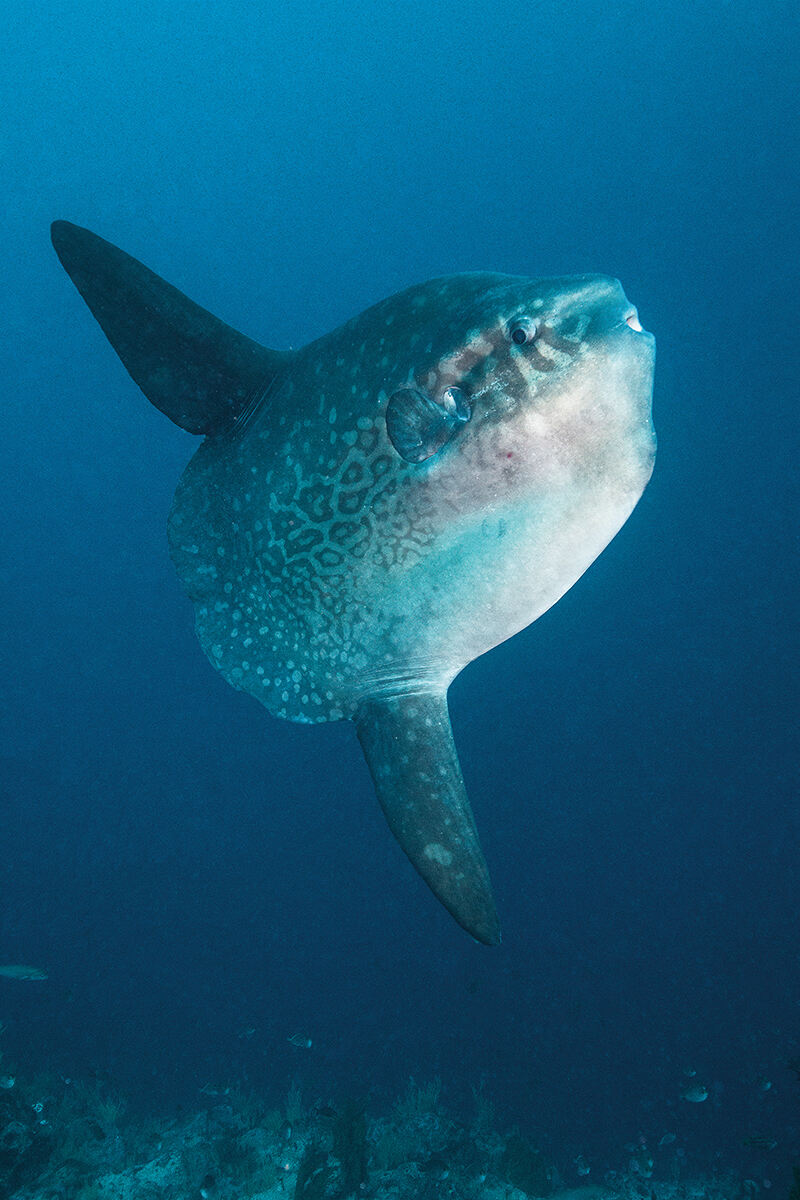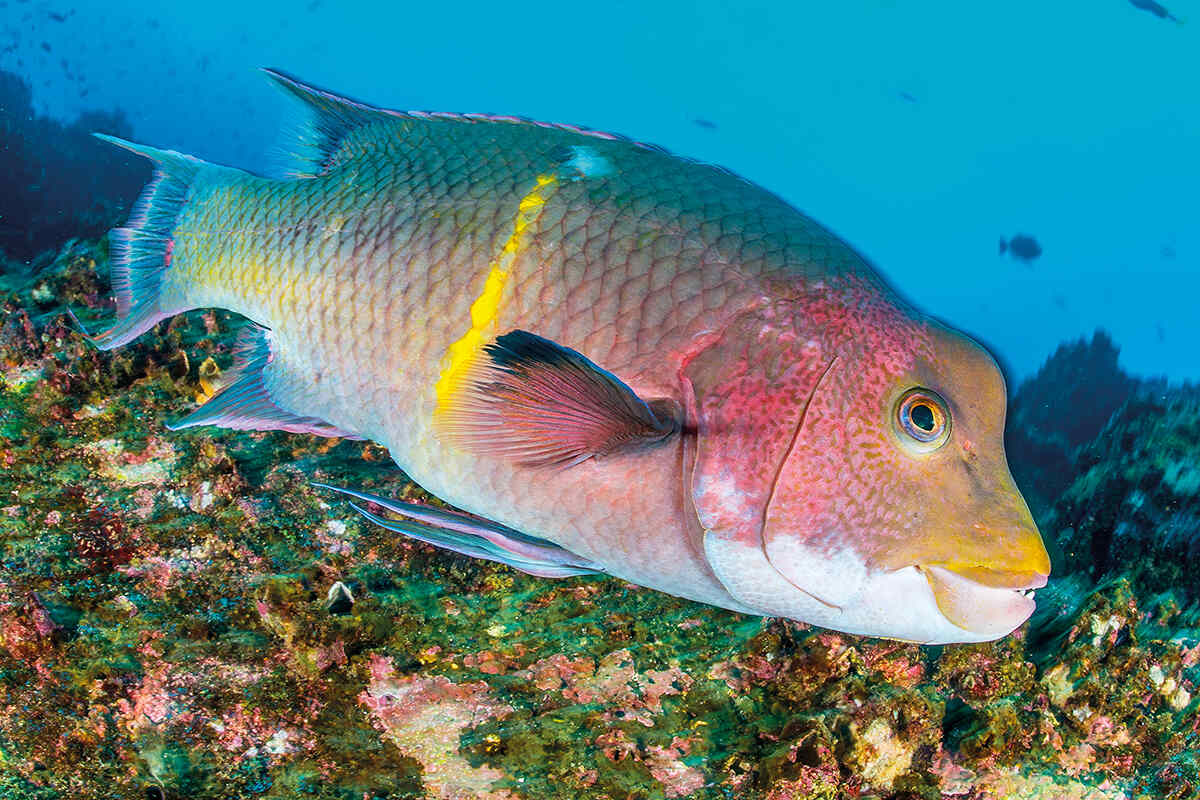
The Galápagos Islands are still one of the most exciting places on earth to dive. But for how much longer? For millennia these unique, isolated outcrops have been an evolutionary laboratory generating bizarre and wonderful life forms and acting as a haven for pelagic wanderers across the Eastern Pacific. However, they now face a tsunami of human-generated problems – overfishing, climate change, population growth and pollution.
Words and photographs by Steve Jones
Sheets of shimmering silver wrap around me as I’m engulfed by a school of steel pompano so dense I cannot see the surface. The school parts as a turtle eases through the current towards me, followed by a squadron of eagle rays gliding in precise configuration above the stream of fish flowing over the reef. Unusual shapes emerge from the blue, as the hammerheads make their entrance into this dreamlike scene that, unless you’ve been here, would take a healthy imagination to even believe. I am diving on Wolf Island and this is the Galápagos that I have long imagined, brimming with life that seems so perfectly adapted to this evolutionary cauldron.

Exceptional biodiversity is one of many reasons the Galápagos Islands are so fascinating for nature lovers and scientists alike, for there are few places on Earth that equal the sheer intensity of action found in the waters of Wolf and Darwin islands.
These two remote, northern outposts are the tip of an extinct sub-surface volcano that rises more than 1,000 metres from the seabed, with Darwin lying slightly further out than Wolf at around 160km northwest of the archipelago’s largest island, Isabela.
Strong currents dictate that the diving is not for beginners, or the faint-hearted, but for the experienced diver, the rewards are huge. Many claim Darwin’s Arch, a rock formation that stands like a mythical portal to a realm of wonder beyond, is the best dive site in the world. There’s good reason for that.

Entering the water, we drop like stones through the racing water. Waste time, and the reef will be gone in a flash. We shelter among rocky outcrops, careful to avoid the resident morays, and I’m soon distracted by the attentions of the inquisitive hogfish, almost missing the main event unfolding behind me.
Turning, I glimpse the unforgettable swagger of a large scalloped hammerhead shark moving up the reef towards the barberfish that wait like a motor racing pit crew to service their number-one driver. Seconds pass, parasites are devoured and the shark peels off, moving to a holding pattern out in the blue, as others approach for their own turn at the cleaning pit stop.
Dozens of sharks hover in the distance, then fade away like ships drifting into a sea mist. A fast, metallic rattling noise pulls me from my trance, and I see our guide launch into the blue, pointing, seemingly, at nothing. I follow him on this blind chase, my breathing accelerating as the frantic swim continues. Soon though, my faith starts to wane as we see nothing. He must have been mistaken! He wasn’t! A dark mass suddenly appears ahead on a collision course, seconds away. I raise the camera, and the widest lens I have is soon filled with a goliath-sized whale shark which easily could have been 12 metres in length. Passing within a metre, the immensely powerful tail propels the shark upstream, impossible for us to follow. However, several more encounters with this true giant would follow on the dive.
Low gas eventually sends me to the shallows, where Galápagos sharks and hawksbill turtles cruise over a reef bustling with fish. The current sweeps us away, and even then, we are not alone as curious silky sharks cruise in to investigate, before losing interest as our Zodiac approaches.


A sanctuary under pressure
Healthy shark populations are vital to maintain the balance of the Galápagos marine ecosystem, for without their predation to control numbers of mid-sized predators, there would be a catastrophic cascading effect on the population of smaller reef-dwellers.
Yet Ecuador faces a colossal struggle to attain sustainable fishing practices in this region, with vast areas unprotected, and resource shortages making adequate enforcement impossible. Huge loopholes, that allow sharks to be landed as ‘by-catch’, are exploited by Ecuador’s 45,000 fishing vessels, many of which target the sharks along the marine reserves’ borders, catching migratory species as they leave their sanctuary.
It is also estimated that there are more than 600 Chinese fishing vessels operating in these waters, coming from bases in Costa Rica and Chile. Some conservationists fear that Ecuador’s reliance on Chinese investment makes the government reluctant to forcefully challenge these ships. There have been some notable successes but more often a good deal of luck is needed to ensure effective policing, as was the case in August 2017, when the Fu Yuan Yu Leng was apprehended inside the reserve with more than 6,600 shark carcasses onboard, leading to the crew’s arrest and prosecution.


That ship was caught only because it left its tracking system on. Most others operating illegally here, don’t make that mistake and go undetected. As recently as May 2020 a record-breaking haul of 26 tonnes of shark fins was seized by Hong Kong customs officials, worth an estimated £6.9m ($8.6m) found in containers shipped in from Ecuador. It is estimated those fins cost the lives of more than 38,500 sharks of already endangered species.
Ecuador and China are not the only countries pillaging these waters. Fishing vessels come in from Peru, Panama and Colombia, equally as drawn to this environmentally pristine area as nature lovers, yet with very different outcomes. Nearby Cocos and other shark hotspots suffer similar insidious threats, and unless there is a concerted international effort to work with these countries to tackle this problem at the root, it is inevitably a matter of time before the destruction of one of the most ecologically important places on Earth – an outcome that also would be disastrous for islanders who rely so heavily on tourist dollars.


Endemic delights
Galápagos straddles the Equator at the centre of the western hemisphere, some 600 miles off the coast of Ecuador, and among the animals and plants found nowhere else are giant tortoises, Galápagos fur seals and one of the world’s rarest birds, the flightless cormorant. Studied by Charles Darwin during the second voyage of HMS Beagle, his findings here contributed to the theory of evolution by means of natural selection.
Another unique inhabitant, the Galápagos marine iguana, is a living testament to this theory. Endemic to the islands, and the only ocean-going lizard found on the planet, evolution has enabled it to feed on the algae that grows on submerged rocks, thereby tapping into an abundant food source in an environment that should be totally hostile to these cold-blooded lizards.
Thought to have evolved from a common ancestor that drifted here on fallen vegetation from the American continent around 10.5 million years ago, the marine iguana diverged from the three species of land iguana several million years later. It evolved a flattened tail that is perfect for swimming, sharp claws to stop themselves being swept from the rocks, and a short snout perfect for tearing off algae. Their dark skin enables them to absorb heat quickly when they return from the sea with cooled bodies. You will often see them sneezing, but they have not caught a cold from prolonged immersion – instead, they are expelling excess salt, trapped by a special gland connected to their nostrils which has evolved for that very job!


Our itinerary on the liveaboard Galápagos Aggressor III brings us to the westernmost island, Fernandina. This is one of the most unspoilt areas, with no invasive species and visits that are strictly controlled to keep it that way, for the wildlife here already has enough natural threats to contend with: the nearby active volcano ‘La Cumbre’ has erupted as recently as 2009.
Our affable guide, Walter, describes this as the ‘warm day’ of our trip, knowing it will be anything but, for it is here that the upwelling Cromwell Current turns the water cold, green and incredibly rich in nutrients.

We come to a stop at Cabo Douglas on the northwest of the island, one of the few spots we are allowed to dive on Fernandina. Dark shadows cross our bow as sea lions and turtles swim, while in the background is a shoreline laced with iguana. A surreal scene unfolds underwater, where countless numbers of this sea lizard graze on the algae, unbothered by our presence. Huge green turtles cruise back and forth, yet our study of them is frequently interrupted by the playful sea lions vying for attention. Further out in deeper water, more strange creatures can be seen, including the rarely sighted red-lipped batfish and endemic Galápagos horned shark.
Without a sustained threat from predators, the marine iguana has evolved few natural defences. It comes as no surprise that it is humankind that poses the biggest threat to this species, for over the centuries we have introduced cats, dogs, rats and pigs to the islands, all of which prey on this docile animal and its eggs, wreaking havoc on the populations. Along with other threats such as algae shortages during climate-change-accelerated El Niño weather events, cutting a swathe through the lizard populations, this species is yet another of the ever-growing list that is vulnerable to extinction.

Yet it’s not all doom and gloom for the iguana, as evolution has again lent a hand to ensure this species is more resilient than it would seem. During El Niño food shortages, they not only get thinner but also shorter, possibly due to their bodies feeding off their own bone structure and they can switch between growth and shrinkage throughout their lives, depending on food supply. This finding, reported in the scientific journal Nature, is the first known example of an adult vertebrate being able to shrink its body during times of famine. The marine iguanas have also been observed feeding off terrestrial vegetation when ocean algae sources run low. This fascinating sea lizard, it seems, may yet have a few tricks up its sleeve. It remains an open question whether the other inhabitants of this wild, evolutionary laboratory faced with staggering human greed, are as resilient.


Chinese stand-off
By midsummer this year, the gathering of a huge offshore Chinese fishing fleet in international waters right on the boundaries of the Galápagos again drew attention to this region for all the wrong reasons. Global media outlets reported horror stories that this fleet was ‘pulling everything out of the sea’ along with images of finned whale shark corpses washing ashore in mainland Ecuador, accompanied by the inevitable tide of plastic waste discarded by the fishing boats.
International condemnation came swiftly and, whether by design or yielding to pressure, China eventually agreed to suspend fishing activities in this region from September for three months; and it insisted the fleet was not in the area to target sharks. While it is true that this fleet, or at least the majority of it, was targeting squid, it is worth noting that the squid species in these waters are themselves over-harvested. No matter what its main objective, a fleet of this magnitude will inevitably cause significant environmental collateral damage to such an ecologically sensitive area.

Whether the sharks are killed as by-catch or as the target fish is irrelevant. These crucial populations are under dire stress. Given that this is the fourth year in a row that this fleet has turned up on the outskirts of the protected zone, it is a significant danger. The reality is that illegal shark fishing has long been a threat to Galápagos. It is also worth pointing out that many of the countries that quickly joined the bandwagon of condemnation of China have dubious track records themselves on matters of conservation, with several operating their own offshore fishing fleets which show a similar disregard for the environment, while others are keen customers of China’s seafood exports – the produce being landed by the very same fleets they condemn. These fleets will continue to operate for as long as there is worldwide demand for their catch. The inescapable conclusion is that in an overpopulated world whose finite resources are strained, coupled with an insatiable human demand that continually puts profit before responsible stewardship, an area as rich as Galápagos faces a struggle of previously unseen scale if it is to survive.
We all have a part to play in the future of the Galápagos. One way to help is to support the local economy in a sustainable way by visiting as a diver, giving you the chance to experience what is still one of the most exciting marine environments on the planet.
Getting there
Diving
Steve Jones dived in the Galápagos on the superbly run Galápagos Aggressor III
www.aggressor.com
Flying
Fly to Ecuador. Guayaquil is the nearest international airport and is served by KLM among others. From here you can take a regional flight out to the islands. Aggressor fleet can organise your regional flight with extra baggage allowance
When to go
Year-round. January to May has warmer waters, calmer seas and the chance of seeing manta rays. June to December is cooler above and below water, often with poorer visibility but with the increased chance of seeing whale sharks. A 7 mm hooded semi-dry wetsuit is recommended
Visas
Info can be found here:
wikipedia.org/Visa_policy_Ecuador
Electricity
120-volt, 60 Hz, flat 2-pin plugs in use.
www.power-sockets.com/ecuador


